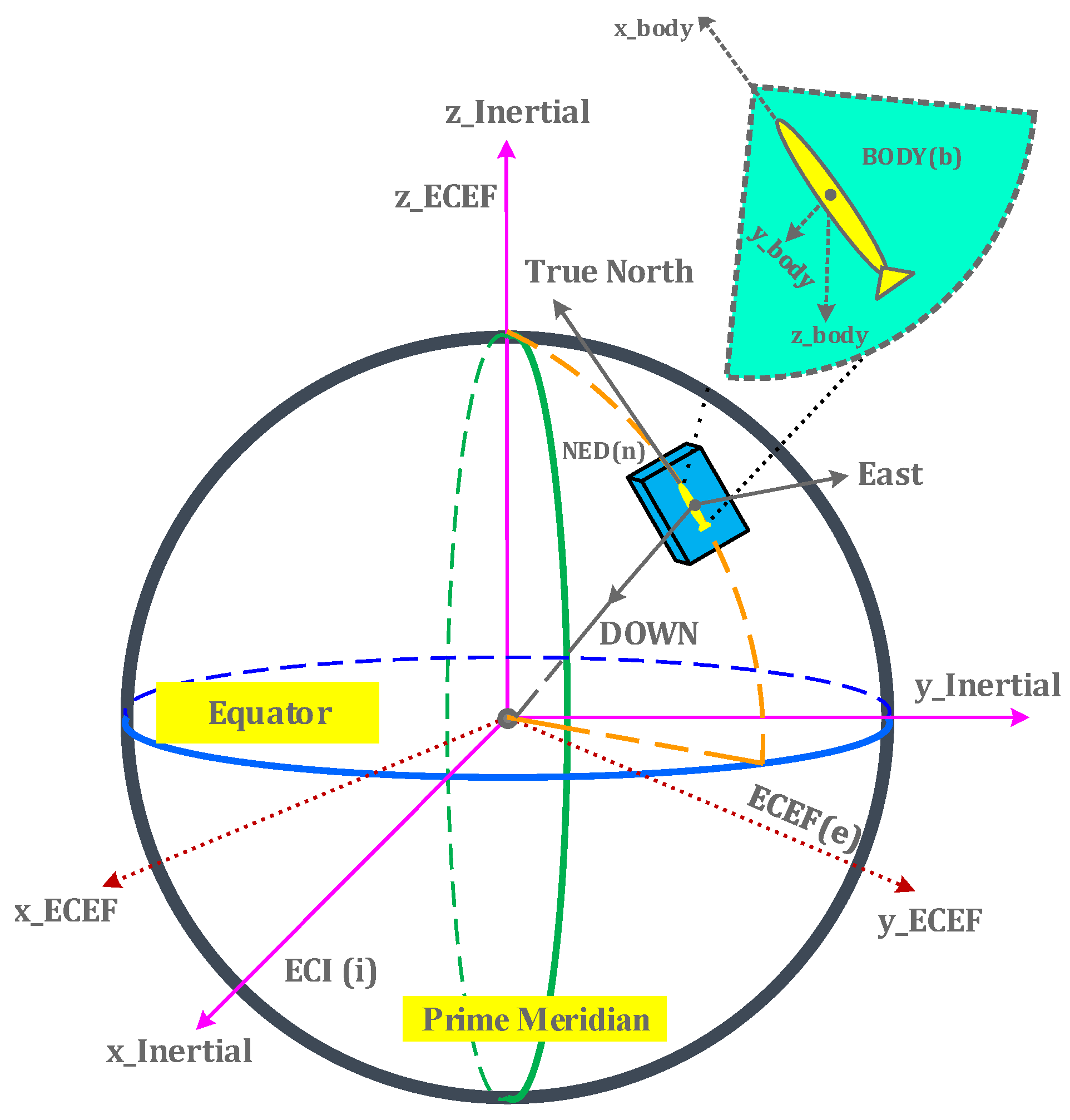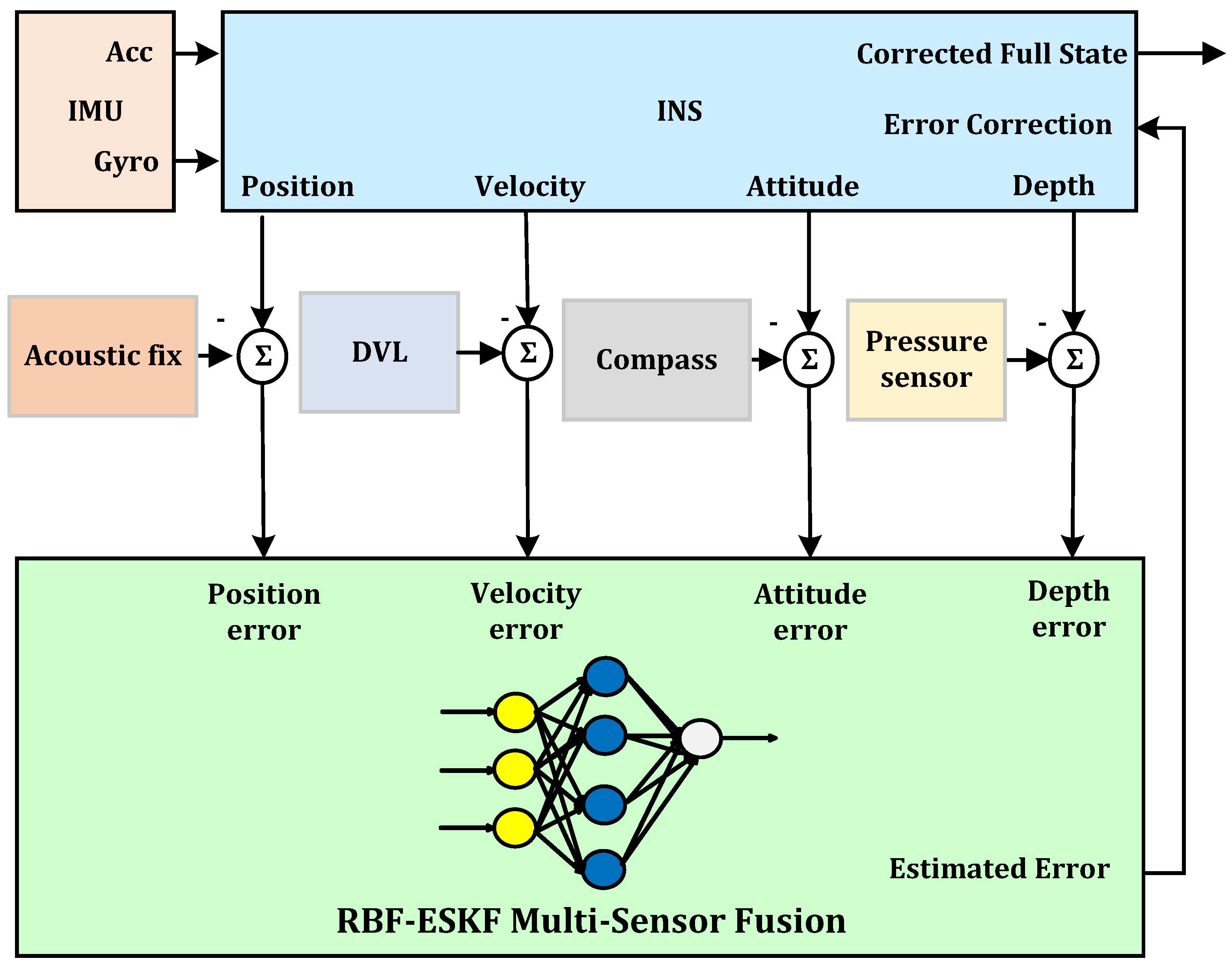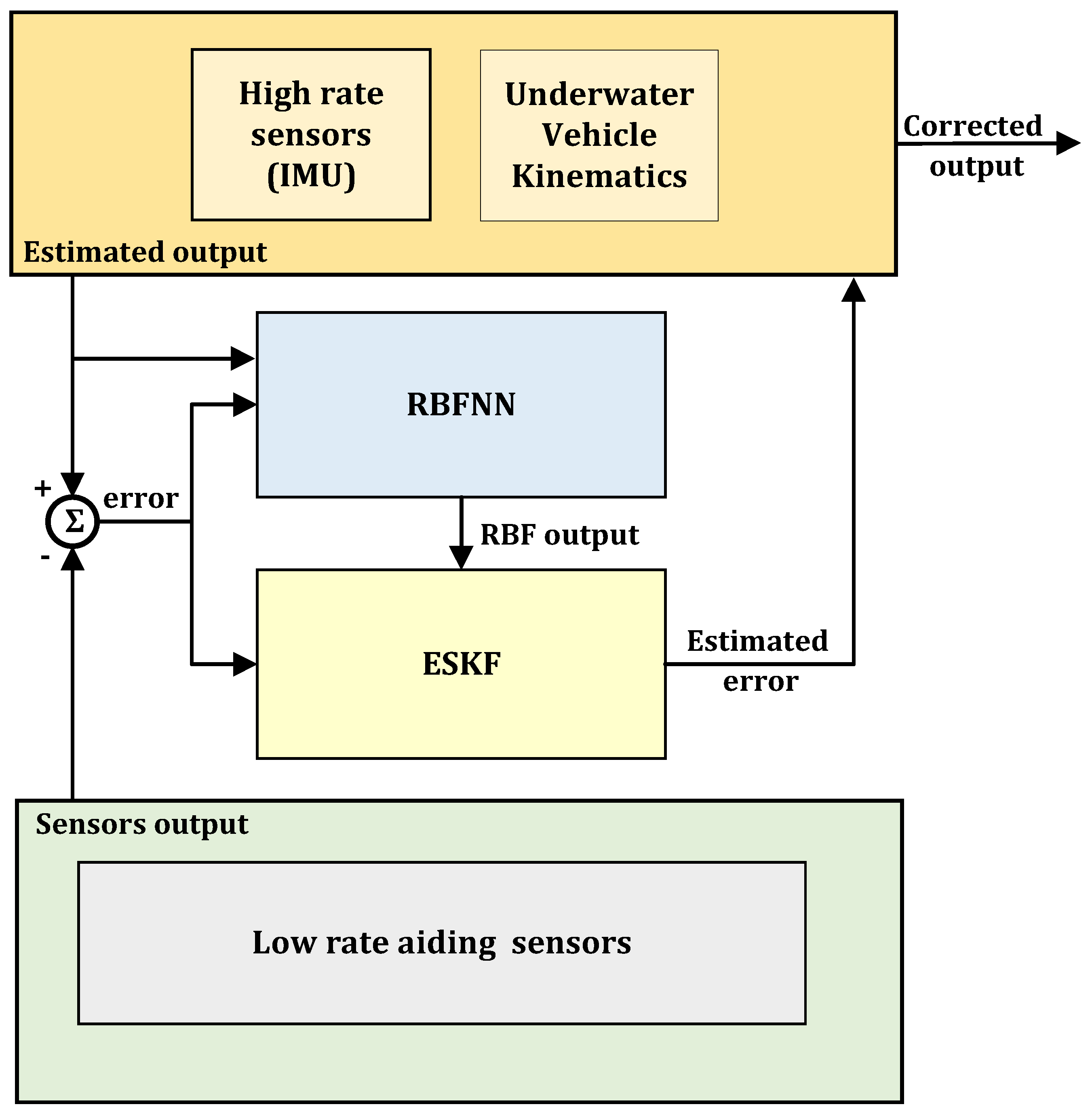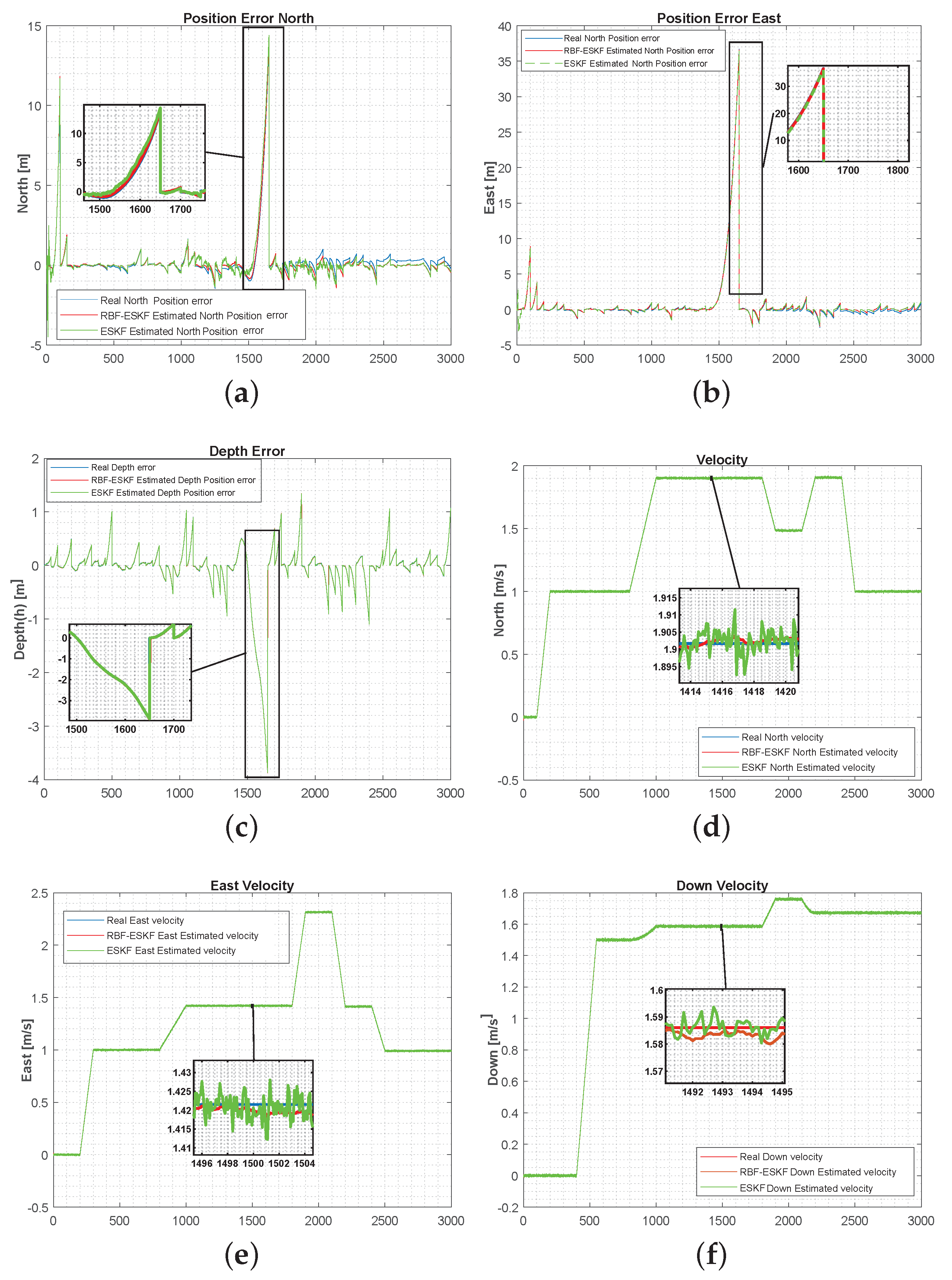Multi-Sensor Fusion for Underwater Vehicle Localization by Augmentation of RBF Neural Network and Error-State Kalman Filter
Abstract
1. Introduction
1.1. State-of-the-Art Review
1.2. Contributions of the Paper
2. Mathematical Modeling
2.1. Frame of References
2.2. Mathematical Notation
2.3. Navigation Equations
3. Sensors on the Vehicle
3.1. Inertial Measurement Unit
3.2. Underwater Acoustic Positing System
3.3. Doppler Velocity Log
3.4. Depth Sensor
3.5. Magnetometer
4. Error Dynamic Model
5. RBF-ESKF Mulit-Sensor Fusion
5.1. RBF-ESKF Mathematical Formulation
- Initialization of the state variables.
- Initialization covariance matrix.
- Initialization process noise covariance.
- Initialization of measurement noise covariance.
5.2. Derivation of Weight Update of RBF-ESKF
5.3. Derivation of Center Update of RBF-ESKF
| Algorithm 1 RBF-ESKF multi-sensor fusion for underwater navigation |
|
5.4. Complexity of RBF-ESKF
6. Results and Discussion
6.1. Test Case 1: Normal Working Condition
6.2. Test Case 2: Acoustic Fix Not Available
6.3. Test Case 3: DVL Unavailable
7. Conclusions
Author Contributions
Funding
Institutional Review Board Statement
Informed Consent Statement
Data Availability Statement
Acknowledgments
Conflicts of Interest
References
- Xu, C.; Xu, C.; Wu, C.; Qu, D.; Liu, J.; Wang, Y.; Shao, G. A novel self-adapting filter based navigation algorithm for autonomous underwater vehicles. Ocean Eng. 2019, 187, 106146. [Google Scholar] [CrossRef]
- Allotta, B.; Chisci, L.; Costanzi, R.; Fanelli, F.; Fantacci, C.; Meli, E.; Ridolfi, A.; Caiti, A.; Di Corato, F.; Fenucci, D. A comparison between EKF-based and UKF-based navigation algorithms for AUVs localization. In Proceedings of the OCEANS 2015—Genova, Genoa, Italy, 18–21 May 2015; pp. 1–5. [Google Scholar] [CrossRef]
- Chen, H.; Gong, Y.; Hong, X.; Chen, S. A Fast Adaptive Tunable RBF Network For Nonstationary Systems. IEEE Trans. Cybern. 2016, 46, 2683–2692. [Google Scholar] [CrossRef] [PubMed]
- Tomczyk, K.; Piekarczyk, M.; Sokal, G. Radial basis functions intended to determine the upper bound of absolute dynamic error at the output of voltage-mode accelerometers. Sensors 2019, 19, 4154. [Google Scholar] [CrossRef]
- Lu, S.; Başar, T. Robust nonlinear system identification using neural-network models. IEEE Trans. Neural Netw. 1998, 9, 407–429. [Google Scholar] [CrossRef]
- Li, D.M.; Li, F.C. Identification of chaotic systems with noisy data based on RBF neural networks. In Proceedings of the 2009 International Conference on Machine Learning and Cybernetics, Hebei, China, 12–15 July 2009; Volume 5, pp. 2578–2581. [Google Scholar] [CrossRef]
- Groves, P.D. Navigation using inertial sensors [Tutorial]. IEEE Aerosp. Electron. Syst. Mag. 2015, 30, 42–69. [Google Scholar] [CrossRef]
- Kepper, J.H.; Claus, B.C.; Kinsey, J.C. A Navigation Solution Using a MEMS IMU, Model-Based Dead-Reckoning, and One-Way-Travel-Time Acoustic Range Measurements for Autonomous Underwater Vehicles. IEEE J. Ocean. Eng. 2019, 44, 664–682. [Google Scholar] [CrossRef]
- Melo, J.; Matos, A. Survey on advances on terrain based navigation for autonomous underwater vehicles. Ocean Eng. 2017, 139, 250–264. [Google Scholar] [CrossRef]
- González-García, J.; Gómez-Espinosa, A.; Cuan-Urquizo, E.; García-Valdovinos, L.G.; Salgado-Jiménez, T.; Escobedo Cabello, J.A. Autonomous underwater vehicles: Localization, navigation, and communication for collaborative missions. Appl. Sci. 2020, 10, 1256. [Google Scholar] [CrossRef]
- Ullah, I.; Chen, J.; Su, X.; Esposito, C.; Choi, C. Localization and Detection of Targets in Underwater Wireless Sensor Using Distance and Angle Based Algorithms. IEEE Access 2019, 7, 45693–45704. [Google Scholar] [CrossRef]
- Paull, L.; Saeedi, S.; Seto, M.; Li, H. AUV Navigation and Localization: A Review. IEEE J. Ocean. Eng. 2014, 39, 131–149. [Google Scholar] [CrossRef]
- Qureshi, U.M.; Aziz, Z.; Shaikh, F.K.; Aziz, Z.; Shah, S.M.S.; Shah, S.M.S.; Sheikh, A.A.; Felemban, E.; Qaisar, S.B. RF path and absorption loss estimation for underwaterwireless sensor networks in differentwater environments. Sensors 2016, 16, 890. [Google Scholar] [CrossRef]
- Diversi, R.; Guidorzi, R.; Soverini, U. Kalman filtering in extended noise environments. IEEE Trans. Autom. Control 2005, 50, 1396–1402. [Google Scholar] [CrossRef]
- Almeida, J.; Matias, B.; Ferreira, A.; Almeida, C.; Martins, A.; Silva, E. Underwater localization system combining iusbl with dynamic sbl in ¡vamos! trials. Sensors 2020, 20, 4710. [Google Scholar] [CrossRef] [PubMed]
- Ko, N.Y.; Jeong, S.; Hwang, S.S.; Pyun, J.Y. Attitude estimation of underwater vehicles using field measurements and bias compensation. Sensors 2019, 19, 330. [Google Scholar] [CrossRef]
- Huang, H.; Chen, X.; Zhou, Z.; Xu, Y.; Lv, C. Study of the algorithm of backtracking decoupling and adaptive extended kalman filter based on the quaternion expanded to the state variable for underwater glider navigation. Sensors 2014, 14, 23041–23066. [Google Scholar] [CrossRef]
- Miller, A.; Miller, B.; Miller, G. On AUV control with the aid of position estimation algorithms based on acoustic seabed sensing and DOA measurements. Sensors 2019, 19, 5520. [Google Scholar] [CrossRef]
- Tal, A.; Klein, I.; Katz, R. Inertial navigation system/doppler velocity log (INS/DVL) fusion with partial dvl measurements. Sensors 2017, 17, 415. [Google Scholar] [CrossRef] [PubMed]
- Zhang, M.; Li, K.; Hu, B.; Meng, C. Comparison of Kalman Filters for Inertial Integrated Navigation. Sensors 2019, 19, 1426. [Google Scholar] [CrossRef]
- Sun, C.; Zhang, Y.; Wang, G.; Gao, W. A new variational bayesian adaptive extended kalman filter for cooperative navigation. Sensors 2018, 18, 2538. [Google Scholar] [CrossRef]
- Chen, L.; Fang, J. A Hybrid Prediction Method for Bridging GPS Outages in High-Precision POS Application. IEEE Trans. Instrum. Meas. 2014, 63, 1656–1665. [Google Scholar] [CrossRef]
- Jingsen, Z.; Wenjie, Z.; Bo, H.; Yali, W. Integrating Extreme Learning Machine with Kalman Filter to Bridge GPS Outages. In Proceedings of the 2016 3rd International Conference on Information Science and Control Engineering, ICISCE 2016, Beijing, China, 8–10 July 2016; pp. 420–424. [Google Scholar] [CrossRef]
- Huang, X.L.; Ma, X.; Hu, F. Editorial: Machine Learning and Intelligent Communications. Mob. Netw. Appl. 2018, 23, 68–70. [Google Scholar] [CrossRef]
- Tsiropoulou, E.E.; Mitsis, G.; Papavassiliou, S. Interest-aware energy collection & resource management in machine to machine communications. Ad Hoc Netw. 2018, 68, 48–57. [Google Scholar] [CrossRef]
- Zhang, X.; Mu, X.; Liu, H.; He, B.; Yan, T. Application of Modified EKF Based on Intelligent Data Fusion in AUV Navigation. In Proceedings of the 2019 IEEE Underwater Technology (UT), Kaohsiung, Taiwan, 16–19 April 2019; pp. 1–4. [Google Scholar] [CrossRef]
- Sabet, M.T.; Mohammadi Daniali, H.; Fathi, A.; Alizadeh, E. A Low-Cost Dead Reckoning Navigation System for an AUV Using a Robust AHRS: Design and Experimental Analysis. IEEE J. Ocean. Eng. 2018, 43, 927–939. [Google Scholar] [CrossRef]
- Allotta, B.; Caiti, A.; Chisci, L.; Costanzi, R.; Di Corato, F.; Fantacci, C.; Fenucci, D.; Meli, E.; Ridolfi, A. An unscented Kalman filter based navigation algorithm for autonomous underwater vehicles. Mechatronics 2016, 39, 185–195. [Google Scholar] [CrossRef]
- Julier, S.; Uhlmann, J.; Durrant-Whyte, H. A new method for the nonlinear transformation of means and covariances in filters and estimators. IEEE Trans. Autom. Control 2000, 45, 477–482. [Google Scholar] [CrossRef]
- Karimi, M.; Bozorg, M.; Khayatian, A.R. A comparison of DVL/INS fusion by UKF and EKF to localize an autonomous underwater vehicle. In Proceedings of the 2013 First RSI/ISM International Conference on Robotics and Mechatronics (ICRoM), Tehran, Iran, 13–15 February 2013; pp. 62–67. [Google Scholar] [CrossRef]
- Tsyganova, J.V.; Kulikova, M.V. SVD-Based Kalman Filter Derivative Computation. IEEE Trans. Autom. Control 2017, 62, 4869–4875. [Google Scholar] [CrossRef]
- Huang, G.; Mourikis, A.; Roumeliotis, S. On the complexity and consistency of UKF-based SLAM. In Proceedings of the 2009 IEEE International Conference on Robotics and Automation, Kobe, Japan, 12–17 May 2009; pp. 4401–4408. [Google Scholar] [CrossRef]
- Simon, D. Training radial basis neural networks with the extended Kalman filter. Neurocomputing 2002, 48, 455–475. [Google Scholar] [CrossRef]
- Wang, Y.; Chai, S.; Nguyen, H.D. Experimental and numerical study of autopilot using Extended Kalman Filter trained neural networks for surface vessels. Int. J. Nav. Archit. Ocean. 2020, 12, 314–324. [Google Scholar] [CrossRef]
- Kurban, T.; Beşdok, E. A Comparison of RBF Neural Network Training Algorithms for Inertial Sensor Based Terrain Classification. Sensors 2009, 9, 6312–6329. [Google Scholar] [CrossRef]
- Dong, X.; Wu, J.; Wang, S.; Chen, T. An improved CDKF algorithm based on RBF neural network for satellite attitude determination. In Proceedings of the 2012 International Conference on Image Analysis and Signal Processing, IASP 2012, Huangzhou, China, 9–11 November 2012; pp. 155–161. [Google Scholar] [CrossRef]
- Pesce, V.; Silvestrini, S.; Lavagna, M. Radial basis function neural network aided adaptive extended Kalman filter for spacecraft relative navigation. Aerosp. Sci. Technol. 2020, 96, 105527. [Google Scholar] [CrossRef]
- Chen, T.; Chen, H. Approximation capability to functions of several variables, nonlinear functionals, and operators by radial basis function neural networks. IEEE Trans. Neural Netw. 1995, 6, 904–910. [Google Scholar] [CrossRef]
- Markopoulos, A.P.; Georgiopoulos, S.; Manolakos, D.E. On the use of back propagation and radial basis function neural networks in surface roughness prediction. J. Ind. Eng. Int. 2016, 12, 389–400. [Google Scholar] [CrossRef]
- Farrell, J.A. Aided Navigation GPS with High Rate Sensors, 1st ed.; The McGraw-Hill Companies: New York, NY, USA, 2008; p. 553. [Google Scholar]
- Savage, P.G. Strapdown Inertial Navigation Integration Algorithm Design Part 2: Velocity and Position Algorithms. J. Guid. Control. Dyn. 1998, 21, 208–221. [Google Scholar] [CrossRef]
- Miller, P.A.; Farrell, J.A.; Zhao, Y.; Djapic, V. Autonomous Underwater Vehicle Navigation. IEEE J. Ocean Eng. 2010, 35, 663–678. [Google Scholar] [CrossRef]
- Karmozdi, A.; Hashemi, M.; Salarieh, H. Design and practical implementation of kinematic constraints in Inertial Navigation System-Doppler Velocity Log (INS-DVL)-based navigation. Navigation 2018, 65, 629–642. [Google Scholar] [CrossRef]
- Titterton, D.; Weston, J. Strapdown Inertial Navigation Technology, 2nd ed.; Institution of Engineering and Technology, The Institution of Engineering and Technology, Michael Faraday House: Hertfordshire, UK, 2004. [Google Scholar] [CrossRef]
- Valenti, R.G.; Dryanovski, I.; Xiao, J. Keeping a good attitude: A quaternion-based orientation filter for IMUs and MARGs. Sensors 2015, 15, 19302–19330. [Google Scholar] [CrossRef]
- Grewal, M.S.; Andrews, A.P.; Bartone, C.G. Global Navigation Satellite Systems, Inertial Navigation, and Integration; Wiley: New York, NY, USA, 2020. [Google Scholar] [CrossRef]
- Chatfield, A.B. Fundamentals Of High Accuracy Inertial Navigation; American Institute of Aeronautics and Astronautics: Reston, VA, USA, 1997. [Google Scholar] [CrossRef]
- Wang, Q.; Cui, X.; Li, Y.; Ye, F. Performance enhancement of a USV INS/CNS/DVL integration navigation system based on an adaptive information sharing factor federated filter. Sensor 2017, 17, 239. [Google Scholar] [CrossRef] [PubMed]
- He, K.; Liu, H.; Wang, Z. A novel adaptive two-stage information filter approach for deep-sea USBL/DVL integrated navigation. Sensors 2020, 20, 6029. [Google Scholar] [CrossRef]
- Hegrenaes, O.; Ramstad, A.; Pedersen, T.; Velasco, D. Validation of a new generation DVL for underwater vehicle navigation. In Proceedings of the 2016 IEEE/OES Autonomous Underwater Vehicles (AUV), Tokyo, Japan, 6–9 November 2016; pp. 342–348. [Google Scholar] [CrossRef]
- Kang, Y.; Zhao, L.; Cheng, J.; Wu, M.; Fan, X. A Novel Grid SINS/DVL Integrated Navigation Algorithm for Marine Application. Sensors 2018, 18, 364. [Google Scholar] [CrossRef]
- Christ, R.D.; Wernli, R.L. Underwater Acoustics and Positioning. In The ROV Manual; Elsevier Ltd.: Amsterdam, The Netherland, 2007; pp. 81–124. [Google Scholar] [CrossRef]
- Healey, A.; An, E.; Marco, D. Online compensation of heading sensor bias for low cost AUVs. In Proceedings of the 1998 Workshop on Autonomous Underwater Vehicles (Cat. No.98CH36290), Cambridge, MA, USA, 21 August 1998; pp. 35–42. [Google Scholar] [CrossRef]
- Fanelli, F. Development and Testing of Navigation Algorithms for Autonomous Underwater Vehicles, 1st ed.; Springer Theses; Springer International Publishing: Cham, Sweden, 2020. [Google Scholar] [CrossRef]
- Roumeliotis, S.I.; Sukhatme, G.S.; Bekey, G.A. Circumventing Dynamic Modeling: Evaluation of the Error-State Kalman Filter applied to Mobile Robot Localization. In Proceedings of the IEEE International Conference on Robotics and Automation, Detroit, MI, USA, 10–15 May 1999. [Google Scholar] [CrossRef]
- Rogers, R.M. Applied Mathematics in Integrated Navigation Systems, 3rd ed.; American Institute of Aeronautics and Astronautics: Reston, VA, USA, 2007. [Google Scholar] [CrossRef]
- Foss, H.T.H.; Meland, E. Sensor Integration for Nonlinear Navigation System in Underwater Vehicles. Ph.D. Thesis, Norwegian University of Science and Technology, Trondheim, Norway, 2007. [Google Scholar]
- Emami, M.; Taban, M.R. A Low Complexity Integrated Navigation System for Underwater Vehicles. J. Navig. 2018, 71, 1161–1177. [Google Scholar] [CrossRef]
- Dinc, M.; Hajiyev, C. Integration of navigation systems for autonomous underwater vehicles. J. Mar. Eng. Technol. 2015, 14, 32–43. [Google Scholar] [CrossRef]
- Yu, H.; Xie, T.; Paszczynski, S.; Wilamowski, B.M. Advantages of Radial Basis Function Networks for Dynamic System Design. IEEE Trans. Ind. Electron. 2011, 58, 5438–5450. [Google Scholar] [CrossRef]
- Wu, Y.; Wang, H.; Zhang, B.; Du, K.L. Using Radial Basis Function Networks for Function Approximation and Classification. ISRN Appl. Math. 2012, 2012, 1–34. [Google Scholar] [CrossRef]
- Kalman, R.E. A New Approach to Linear Filtering and Prediction Problems. J. Basic Eng. 1960, 82, 35–45. [Google Scholar] [CrossRef]
- Solà, J. Quaternion kinematics for the error-state Kalman filter. arXiv 2017, arXiv:1711.02508. [Google Scholar]
- Bjaili, H.A.; Moinuddin, M.; Rushdi, A.M. A State-Space Backpropagation Algorithm for Nonlinear Estimation. Circuits Syst. Signal Process. 2019, 38, 3682–3696. [Google Scholar] [CrossRef]
- Zhao, Y.; Wang, D.; Wang, L. Convolution Accelerator Designs Using Fast Algorithms. Algorithms 2019, 12, 112. [Google Scholar] [CrossRef]
- Dul, F.; Lichota, P.; Rusowicz, A. Generalized Linear Quadratic Control for a Full Tracking Problem in Aviation. Sensors 2020, 20, 2955. [Google Scholar] [CrossRef] [PubMed]
- Wei, L.; Cappelle, C.; Ruichek, Y. Camera/Laser/GPS Fusion Method for Vehicle Positioning Under Extended NIS-Based Sensor Validation. IEEE Trans. Instrum. Meas. 2013, 62, 3110–3122. [Google Scholar] [CrossRef]
- Pham, M.D.; Low, K.S.; Goh, S.T.; Chen, S. Gain-scheduled extended kalman filter for nanosatellite attitude determination system. IEEE Trans. Aerosp. Electron. Syst. 2015, 51, 1017–1028. [Google Scholar] [CrossRef]







| Notation | Description |
|---|---|
| [u,v,w] | Linear velocity in the body frame (surge, sway, and heave) |
| Attitude in Euler angles from the body to NED frame | |
| Attitude in quaternion from the body to NED frame | |
| [p,q,r] | Angular velocity in the body frame (roll, pitch, and yaw) |
| Position in the NED frame (north, east, and down) | |
| Linear velocity in the NED frame (north, east, and down) | |
| Angular velocity in the NED frame | |
| Position in the ECEF frame | |
| Linear velocity in the ECEF frame | |
| Position in the ECEF geoid (latitude, longitude, and depth) | |
| Rotation matrix from the body to ECEF frame | |
| Skew symmetric matrix of the angular velocity | |
| Skew symmetric matrix in the ECEF frame | |
| Skew symmetric matrix in the body frame | |
| Earth gravity vector in the ECEF frame | |
| Earth gravity vector in the NED frame | |
| Radius of curvature of the prime vertical of Earth | |
| Radius of curvature of the meridian of Earth | |
| a | Semi-major axis of the ellipsoidal Earth model |
| e | Eccentricity of the ellipse approximation of Earth |
| RBFNN | Numbers |
|---|---|
| Input layer neurons | 20 |
| Hidden layer neurons | 50 |
| output layer neurons | 20 |
| Learning rate of weights | 0.001 |
| Learning rate of centers | 0.001 |
| ESKF | RBF-ESKF | |
|---|---|---|
| North Position Max error | 1.1509 | 0.32578 |
| East Position Max error | 0.8218 | 0.45685 |
| Down Position Max error | 0.0081786 | 0.0071222 |
| North Position RMSE | 0.446124 | 0.1464 |
| East Position RMSE | 0.3122 | 0.1844 |
| Down Position RMSE | 0.0040719 | 0.002709 |
| Sum Position RMSE | 0.76239 | 0.333509 |
| North Velocity Max error | 0.038185 | 0.01844 |
| East Velocity Max error | 0.0045943 | 0.0037403 |
| Down Velocity Max error | 0.0032507 | 0.0022476 |
| North Velocity RMSE | 0.039455 | 0.011407 |
| East Velocity RMSE | 0.033652 | 0.012919 |
| Down Velocity RMSE | 0.0035526 | 0.020227 |
| Sum Velocity RMSE | 0.0766596 | 0.0263487 |
| Roll Max error | 0.13268 | 0.060874 |
| Pitch Max error | 0.1809 | 0.16171 |
| Yaw Max error | 0.46624 | 0.36001 |
| Roll RMSE | 0.00039554 | 0.00019122 |
| Pitch RMSE | 0.00055597 | 0.00036354 |
| Yaw RMSE | 0.00049874 | 0.00035049 |
| Sum Attitude RMSE | 0.00145025 | 0.00122578 |
| ESKF | RBF-ESKF | |
|---|---|---|
| North Position Max error | 5.2115 | 1.3849 |
| East Position Max error | 1.4275 | 0.4663 |
| Down Position Max error | 0.033167 | 0.016192 |
| North Position RMSE | 0.94036 | 0.50629 |
| East Position RMSE | 0.66511 | 0.40109 |
| Down Position RMSE | 0.005613 | 0.0039411 |
| Sum Position RMSE | 1.611083 | 0.9113211 |
| North Velocity Max error | 0.040376 | 0.029489 |
| East Velocity Max error | 0.0036513 | 0.0030517 |
| Down Velocity Max error | 0.0061216 | 0.0036592 |
| North Velocity RMSE | 0.0439324 | 0.21818 |
| East Velocity RMSE | 0.065722 | 0.035722 |
| Down Velocity RMSE | 0.0065451 | 0.0039131 |
| Sum Velocity RMSE | 0.1161995 | 0.0614531 |
| Roll Max error | 0.2567 | 0.1231 |
| Pitch Max error | 0.41582 | 0.19178 |
| Yaw Max error | 0.5494 | 0.46001 |
| Roll RMSE | 0.0006135 | 0.00020485 |
| Pitch RMSE | 0.00052358 | 0.00011917 |
| Yaw RMSE | 0.00051363 | 0.0003413 |
| Sum Attitude RMSE | 0.00169071 | 0.00117532 |
| ESKF | RBF-ESKF | |
|---|---|---|
| North Position Max error | 1.9455 | 0.90707 |
| East Position Max error | 0.91649 | 0.63511 |
| Down Position Max error | 0.0084106 | 0.0072865 |
| North Position RMS error | 0.669324 | 0.41818 |
| East Position RMS error | 0.53722 | 0.30722 |
| Down Position RMS error | 0.0049455 | 0.0035131 |
| Sum Position RMS error | 1.2114895 | 0.7289131 |
| North Velocity Max error | 0.105751 | 0.051603 |
| East Velocity Max error | 0.099018 | 0.061305 |
| Down Velocity Max error | 0.0178454 | 0.00897 |
| North Velocity RMS error | 0.191296 | 0.09809 |
| East Velocity RMS error | 0.15337 | 0.079982 |
| Down Velocity RMS error | 0.0092455 | 0.005387 |
| Sum Velocity RMS error | 0.3539115 | 0.183459 |
| Roll Max error | 0.29935 | 0.171758 |
| Pitch Max error | 0.51906 | 0.210442 |
| Yaw Max error | 0.66041 | 0.42246 |
| Roll RMSE | 0.00066481 | 0.000450075 |
| Pitch RMSE | 0.00060017 | 0.00042717 |
| Yaw RMSE | 0.00062205 | 0.000422102 |
| Sum Attitude RMSE | 0.00188703 | 0.001299347 |
| ESKF | ESKF-RBF |
|---|---|
| 0.0028 | 0.0039 |
Publisher’s Note: MDPI stays neutral with regard to jurisdictional claims in published maps and institutional affiliations. |
© 2021 by the authors. Licensee MDPI, Basel, Switzerland. This article is an open access article distributed under the terms and conditions of the Creative Commons Attribution (CC BY) license (http://creativecommons.org/licenses/by/4.0/).
Share and Cite
Shaukat, N.; Ali, A.; Javed Iqbal, M.; Moinuddin, M.; Otero, P. Multi-Sensor Fusion for Underwater Vehicle Localization by Augmentation of RBF Neural Network and Error-State Kalman Filter. Sensors 2021, 21, 1149. https://doi.org/10.3390/s21041149
Shaukat N, Ali A, Javed Iqbal M, Moinuddin M, Otero P. Multi-Sensor Fusion for Underwater Vehicle Localization by Augmentation of RBF Neural Network and Error-State Kalman Filter. Sensors. 2021; 21(4):1149. https://doi.org/10.3390/s21041149
Chicago/Turabian StyleShaukat, Nabil, Ahmed Ali, Muhammad Javed Iqbal, Muhammad Moinuddin, and Pablo Otero. 2021. "Multi-Sensor Fusion for Underwater Vehicle Localization by Augmentation of RBF Neural Network and Error-State Kalman Filter" Sensors 21, no. 4: 1149. https://doi.org/10.3390/s21041149
APA StyleShaukat, N., Ali, A., Javed Iqbal, M., Moinuddin, M., & Otero, P. (2021). Multi-Sensor Fusion for Underwater Vehicle Localization by Augmentation of RBF Neural Network and Error-State Kalman Filter. Sensors, 21(4), 1149. https://doi.org/10.3390/s21041149






